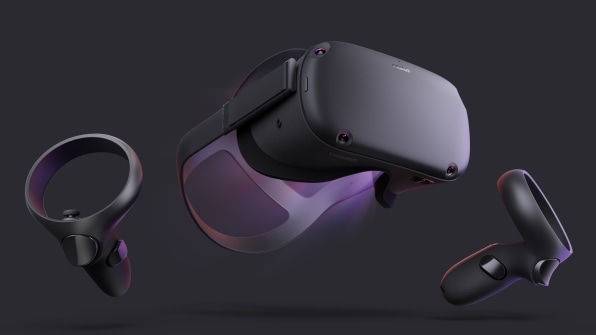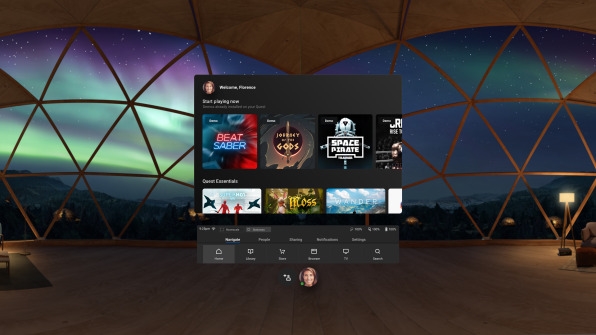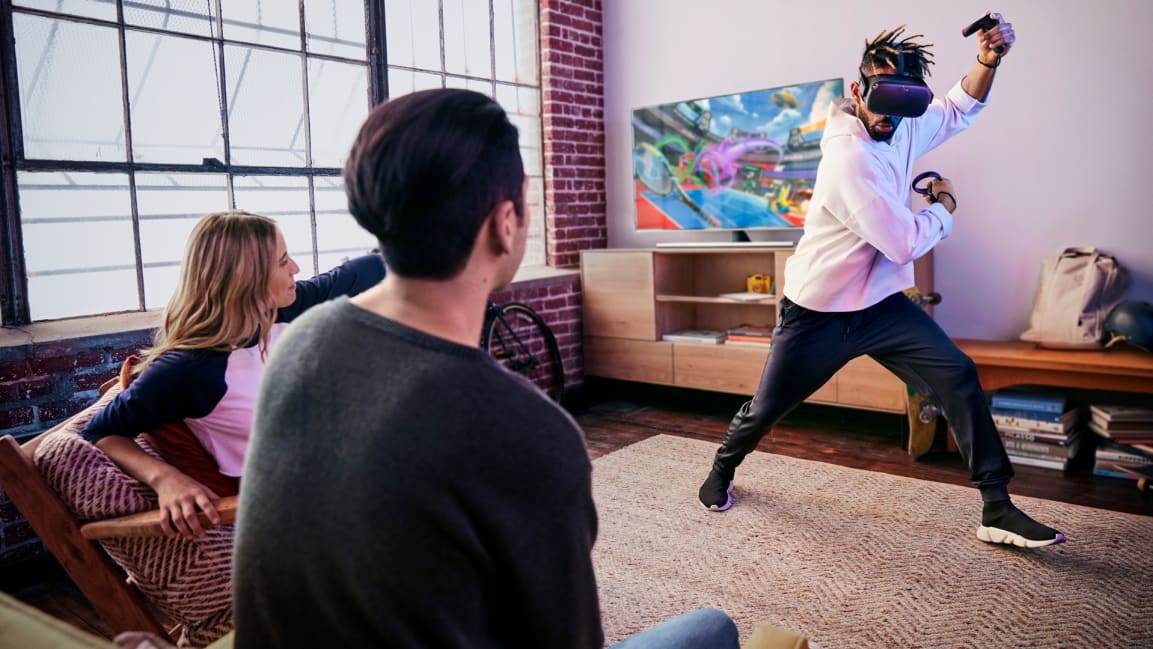The Oculus Quest VR headset will make you sweat, and that’s great
Oculus’s new Quest VR headset may be worth its $399 price tag solely for the exercise using it gives you. In fact, I bet you could get just as good a workout from the Quest as from a much pricier Peloton bike. And maybe even have more fun along the way.
The Quest is notable for its wire-free mobility. Like previous Oculus headsets, it’s still a largish opaque scuba mask-like thing that completely covers your eyes. But it departs from the high-end Rift models by letting you enter VR with no need to tether to a PC. You trade away some visual quality compared to PC-tethered headsets, but what you gain in freedom of movement may be worth it.
The Quest isn’t the company’s first attempt at a self-contained, tether-free headset. Last year’s Oculus Go required neither a PC nor external sensors for tracking and positioning. But the Go didn’t give you full freedom of movement, making it more of a lean-back experience than an active one—which was fine for stuff like watching 3D video, but limiting for games. It also lacked the image processing power of the Quest.
With the Quest, you can do a lot of things in VR–from watching viral videos to shooting zombies–but you can also use it to move your body. When I visited Oculus, on its owner Facebook’s campus, to try out the Quest, I started by playing Armature’s Sports Scramble (Armature) in which I played tennis against a variety of opponents. Except the tennis ball often changed to a ping-pong ball or a beach ball, and my racket would morph into a golf club or some other wacky implement. I was moving around Facebook’s spacious demo space swinging my arms wildly, hitting topspins, backhands, slams, and trying not to think about how ridiculous I may have looked to the Facebook people in the room.

Then I switched over to Survios’s boxing game Creed, where I took on two pretty tough-looking fighters. I felt even sillier then, as I bobbed and weaved and covered up and eventually got knocked on my (virtual) arse by a virtual fighter named “El Tigre.”
Then I realized that I had broken a pretty substantial sweat and I was breathing hard. And whenever you can get a workout without really thinking about it–well, most people would say that’s a bonus. And that’s when I really started liking the idea of the Quest.
When I asked one Oculus engineer about the resolution of the displays inside the headset, he cautioned against reading too much into spec numbers. Resolution, he said, often doesn’t tell the story of VR image quality and how we perceive it. The Quest’s graphics are powered by a fairly powerful Qualcomm Snapdragon 835 chipset, so the graphics are a little gritty but far from janky. Besides, I din’t think about pixels much because I was having too much fun trying to hit beach balls with golf clubs.
Earlier VR headsets use external sensors located around a room to locate you in virtual space—or, like Oculus Go, didn’t try to track anything but your head movement, thereby making the VR less vivid and interactive. But the Quest uses built-in sensors to detect you as you roam around. When you start using the headset, a “Guardian” system lets you establish the limits of the space you can use in the real world. Later, when you’re playing a game and you get close to one of those borders, you see a green grid wall that tells you to stop moving in that direction. If you keep going, the camera on the outside of the headset comes on and you see a “passthrough” view of the real-world barrier that you’re about to run into.
The Guardian and passthrough features worked exactly as billed, saving me some bumps and bruises. They’re especially necessary on the Quest because a big part of the headset’s appeal is your ability to move around. The limits of that freedom are the hard objects in the room around you. So you have to know where those are. Oculus probably could have done this with just the Guardian walls, but the passthrough view gave me an increased sense of safety by verifying that the virtual wall I was seeing corresponded with a real barrier.

There’s also a cool little training program that shows you various kinds of objects (balls, rockets, paper airplanes) and lets you practice grabbing, shooting, throwing, swinging, and other motions. This helped me understand the controller buttons and prepped me for game play later on.
VR tends to be a solitary experience, but the Quest can also “cast” your VR view to a smartphone screen or a TV monitor so others can see what’s happening in your virtual space. The headset uses Wi-Fi networks to cast, and the smartphone must be running the Oculus app. In some games, another person can play along on the smartphone.
The Quest comes preloaded with five demos, including the hand-eye coordination game Beat Saber, Creed, the fantasy fighting game Journey of the Gods, the droid-fighting game Space Pirate Trainer, and Sports Scramble. And Facebook announced that the new Star Wars game Vader Immortal will be available on the headset.
My only real complaint about the Quest isn’t about the headset itself–it’s about my apartment. I wish I’d had about 15 feet of space for side stepping and arm swinging in my favorite game so far, Sports Scramble. If you’ve got more room or can push some furniture out of the way you should have no problem, and other games, like Beat Saber, don’t require as much foot movement.
Along with the Quest, Oculus is also releasing the Rift S VR headset. The Rift S tethers to a PC, so the graphics are more cinematic and detailed than those of the Quest. Both models will begin shipping on May 21, each starting at $399.
Fast Company , Read Full Story
(19)



